Nothing satisfies quite like an authentic Italian cannoli. One bite and you will see why these golden-fried treats line the pastry shop windows of seemingly almost every Italian bakery. A crisp and light fried shell surrounds the sweet and creamy ricotta filling. Add in some mini chocolate chips and a hint of cinnamon, and you have a dessert experience that is simply otherwordly!
But of course, you don’t need to be in Southern Italy to enjoy cannoli. They’re a fantastic recipe to make in the comfort of your own kitchen and are a great treat to bring to your next family dinner, potluck, or housewarming party. Though the cooking process is a bit more involved, I share all my tips to make the process successful, making for the kind of baking therapy afternoons we dream of! For more mouthwatering Italian desserts, check out my homemade biscotti recipe, ladyfingers recipe, and tiramisu cake recipe.
What You Need to Make This Recipe
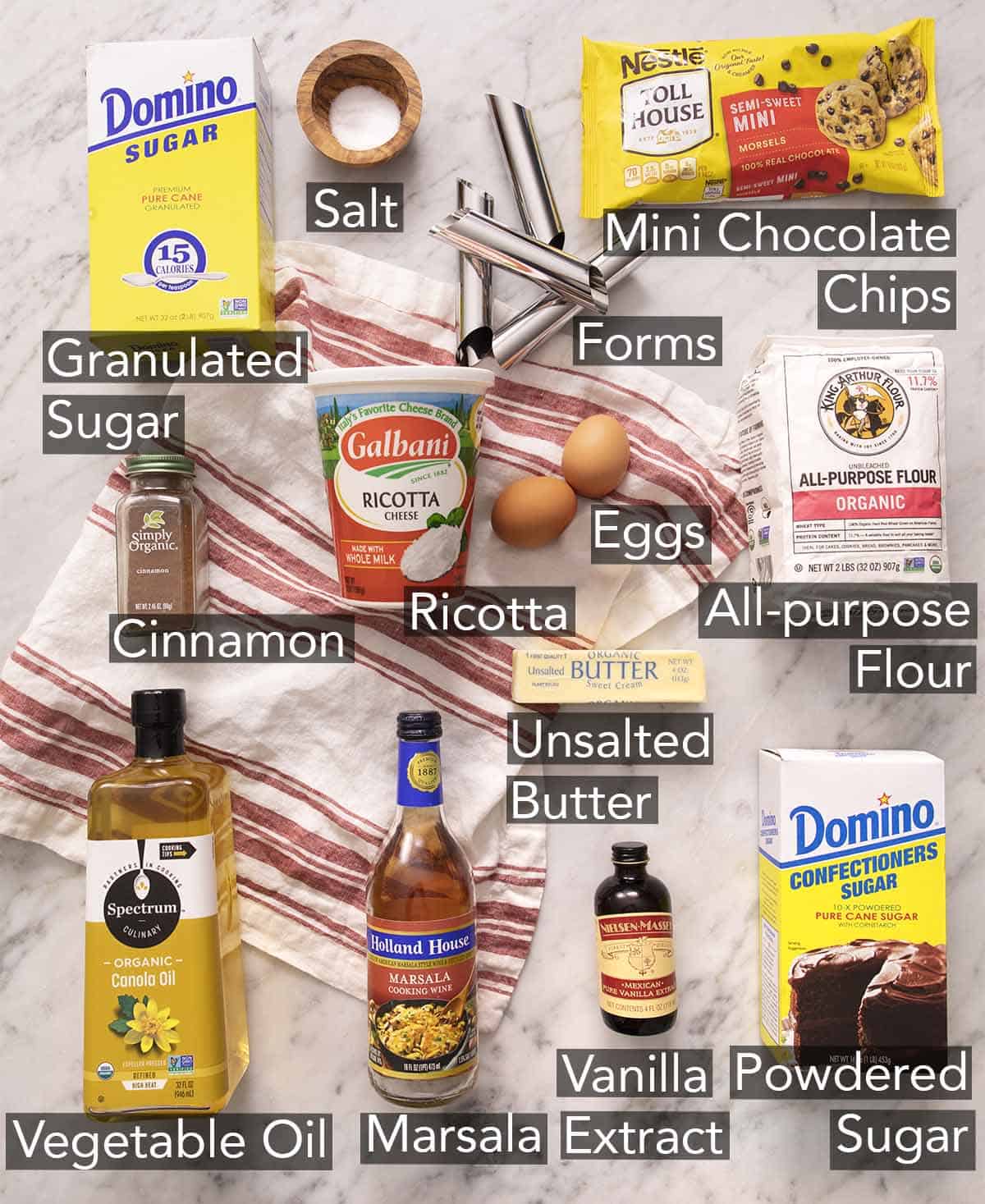
Whole Milk Ricotta Cheese – be sure to choose whole milk ricotta, not skim or 2%, as the fat is needed to make the shells extra tender and flavorful. Be sure to strain the cheese before making the filling; see my recipe notes below on how to do so!
Marsala Wine – the special ingredient in the cannoli dough! Marsala wine makes the shells crispy and flaky while adding nutty brown sugar flavor notes to the dough. If you don’t have marsala wine, another sweet wine like Pinot Grigio or Moscato can substituted.
Eggs – the egg yolks will be used in the dough and the egg whites will be used for assembling, so you will need to separate the eggs before using them in the recipe.
Mini Chocolate Chips – preferably semi-sweet mini chocolate chips. For a richer flavor, use dark chocolate mini chips. If mini chips aren’t available, you can also use regular semi-sweet chocolate chips or shaved chocolate.
Vegetable Oil – choose a neutral-flavored vegetable oil with a high smoke point, such as canola oil, vegetable oil, or grapeseed oil.
Unsalted Butter – opt for unsalted butter, as different brands of butter have different levels of salt. Cut the butter into cubes and use it in the recipe extra cold. I recommend pulling it directly out of the fridge before adding it to the food processor.
How to Make Cannoli
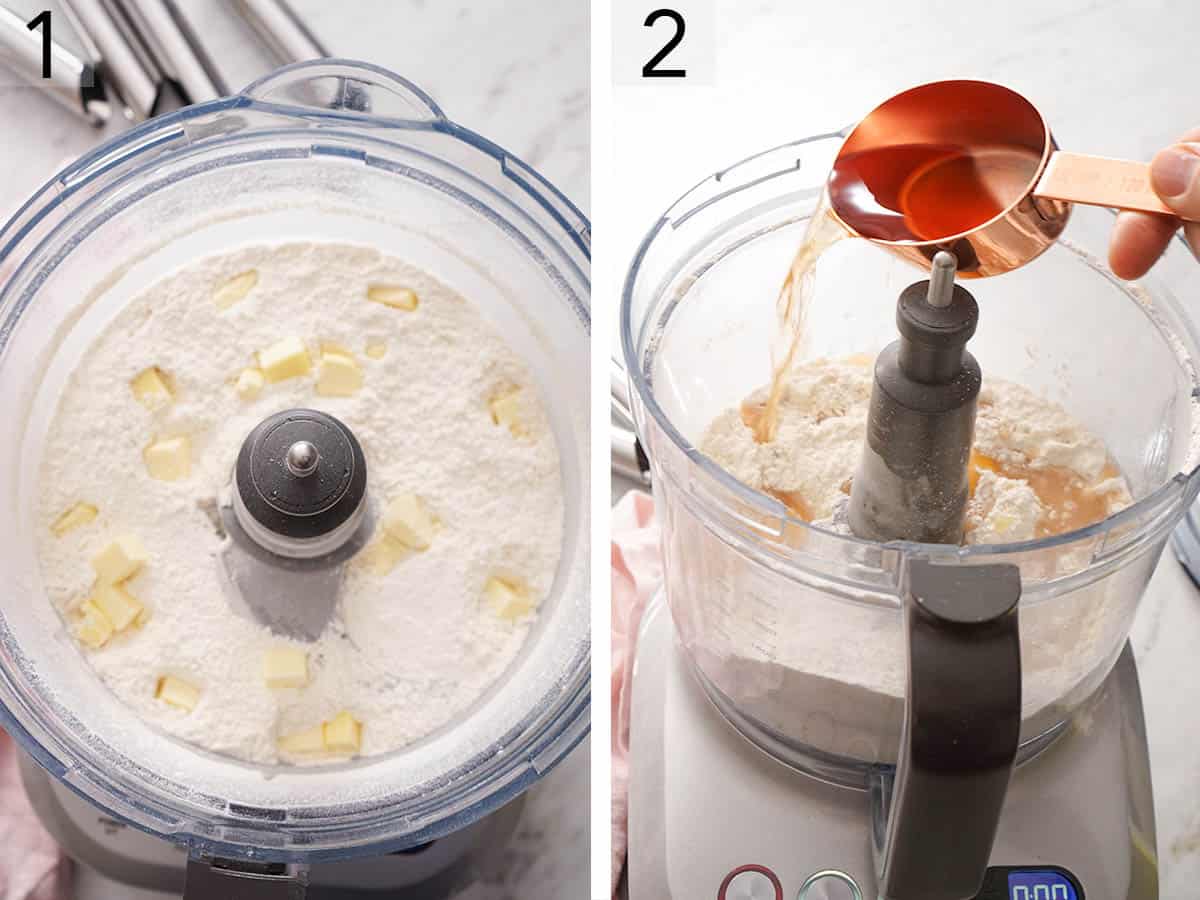
1, Add the flour, sugar, and salt to the bowl of a food processor and pulse to combine. Add the cold butter cubes and pulse until broken up into small pieces, or for about 8 pulses.
2. Add the egg yolks and marsala and pulse until the mixture starts to clump together, you can add more wine by the tablespoon if needed to bring the dough together.
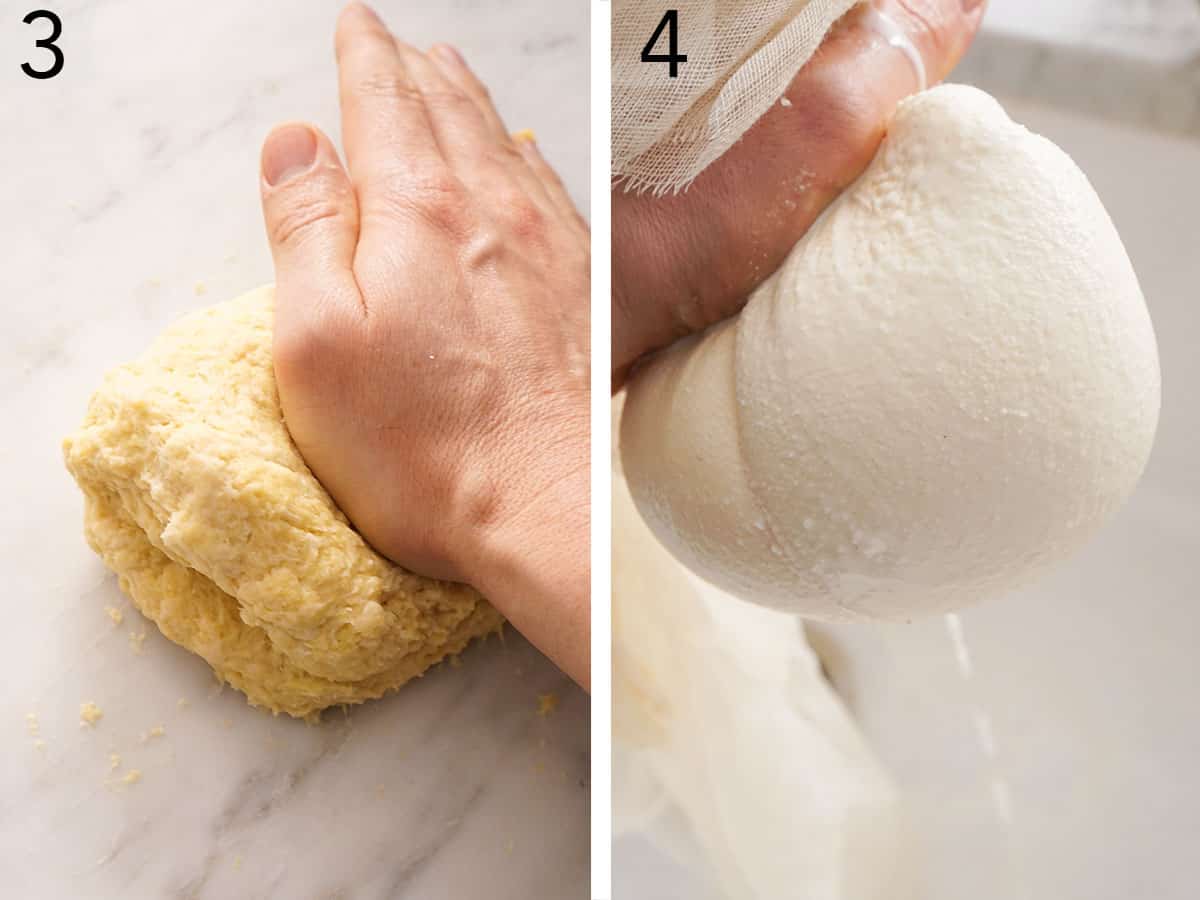
3 Turn the dough out onto a lightly floured counter and knead for 3-4 minutes or until it forms a smooth and elastic dough. Cover and allow to rest at room temperature for an hour.
4. Drain the ricotta by squeezing it in cheesecloth or thin cotton dish towel.
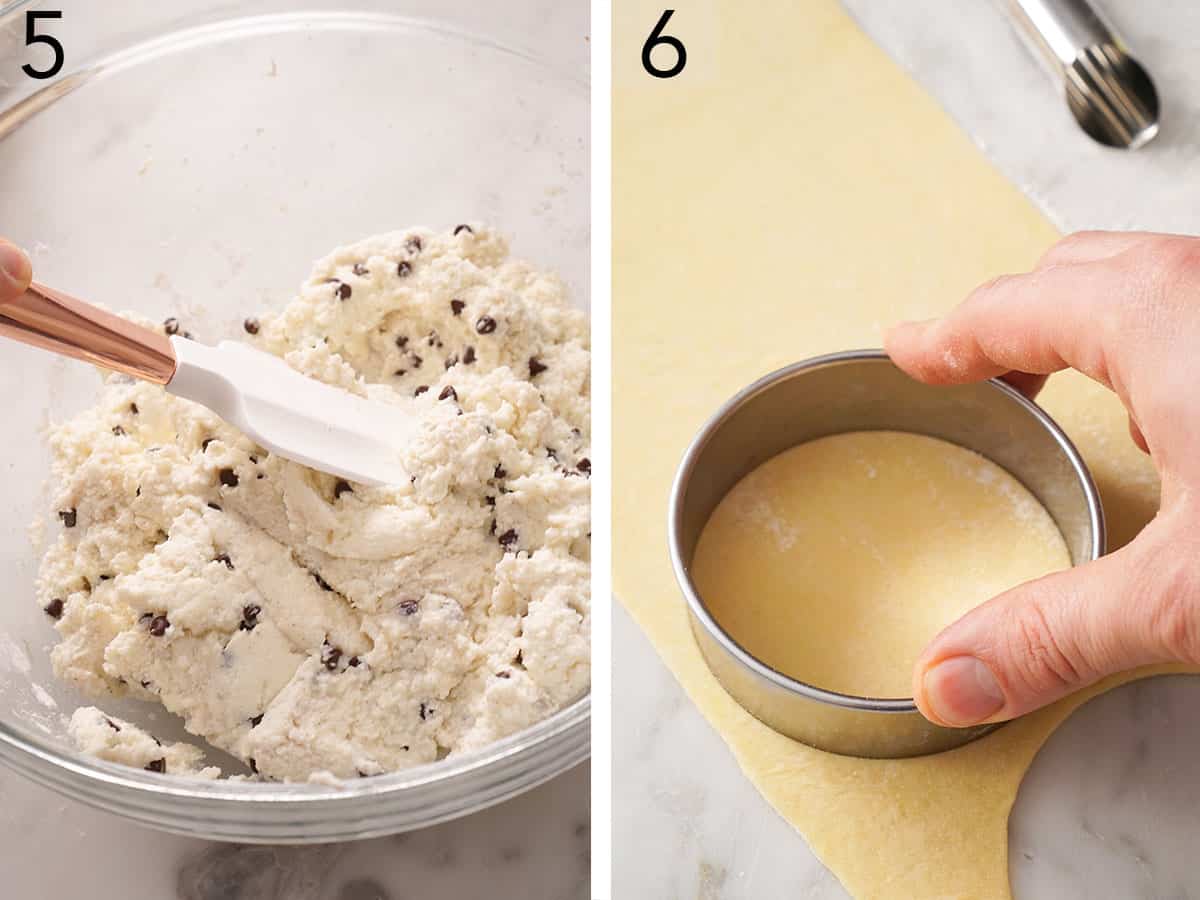
5. Mix the ricotta with powdered sugar, chocolate chip, vanilla, and cinnamon in a large bowl. Stir well until combined. Cover the ricotta filling with plastic wrap and chill for an hour or up to 1 day.
6. Roll the rested cannoli dough out into a ⅛-inch thick sheet. Using a 4-inch round cookie cutter, cut the dough into circles.
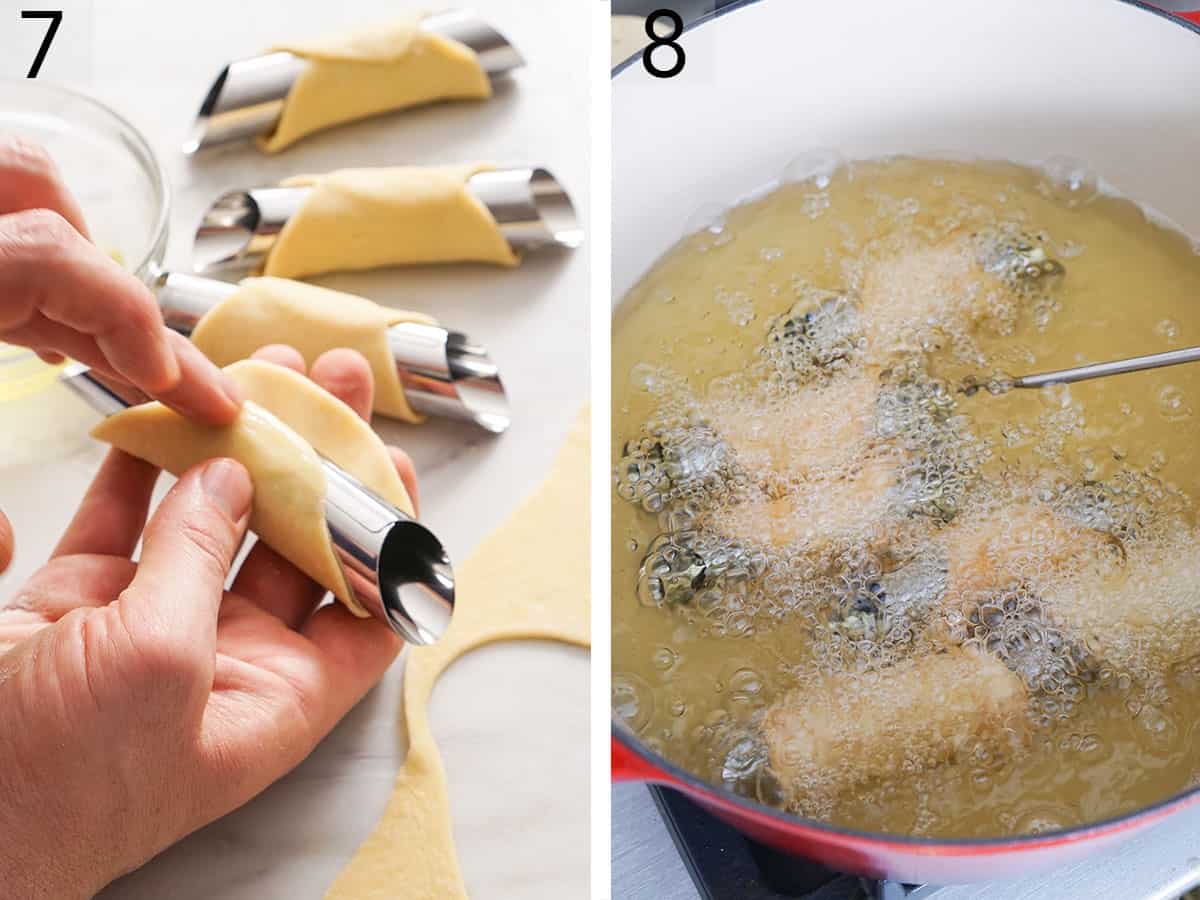
7. Wrap the cannoli dough circles around the metal cannoli forms. Using your finger, wipe some of the reserved egg white on the dough where the dough will overlap.
8. Heat the oil in a large pot over medium heat using a deep-fry thermometer to heat the oil to 360 degrees Fahrenheit. Working in batches, fry the shells in the hot oil for about two minutes, or until the dough is a deep golden brown. Use tongs or a spider strainer to remove the metal from the hot oil and drain on plates lined with paper towels.
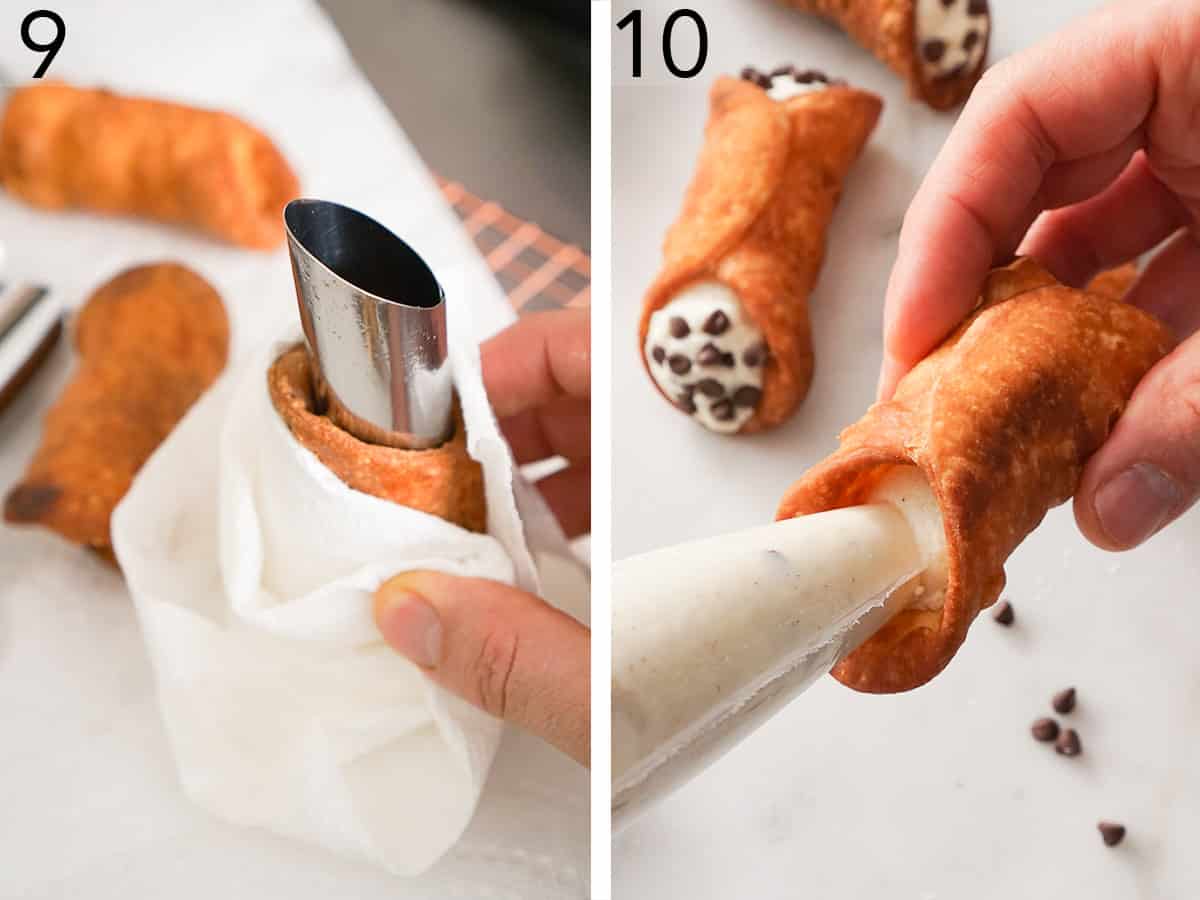
9. While the dough is still piping hot, very carefully remove the metal cannoli tubes. I like to do this by wearing an oven mitt and grabbing the dough with a paper towel as I hold it vertically and gently press down on the wire cooling rack to release the shell from the form.
10. Transfer the chilled ricotta cannoli filling to a piping bag. Snip off the tip of the bag and fill the shells. Press additional mini chocolate chips onto the ends of the cannoli and dust with powdered sugar.
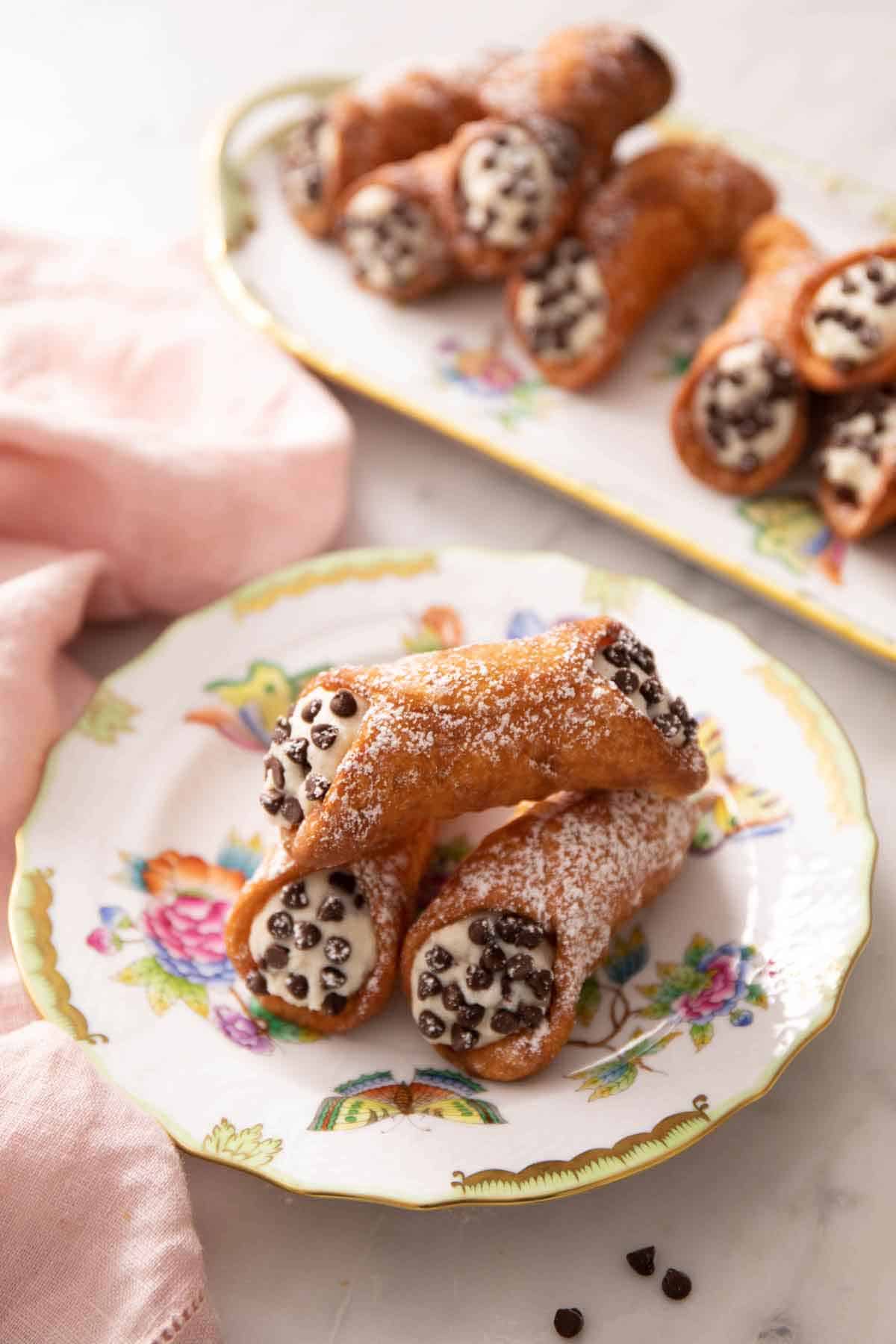
Pro-Tips For Making This Recipe
- Make the ricotta filling while the dough rests. This will give the ricotta mixture time to chill before assembling the cannoli.
- Draining the ricotta. Removing the extra moisture from the cheese gives the filling a smooth and light texture and helps keep the shells from getting soggy. To drain the ricotta, place it in a tightly woven cheesecloth and squeeze the moisture out (as pictured above) or spread the ricotta out on paper towels in a fine mesh strainer or on a dinner plate before patting the cheese down with additional paper towels.
- Rolling the dough thin. To have delicately crispy shells, you will need to roll the dough thin, or to an ⅛-inch thickness. You can do this using a pasta machine or with a rolling pin.
- Re-rolling the scraps of dough. If using the scraps of dough to roll additional cannolis, let them rest for 10-15 minutes before rolling out again to keep the dough from getting tough or chewy.
- Keep an eye on the frying temperature of the oil. It is important to keep the oil at 360 degrees Fahrenheit while frying so the dough doesn’t burn or get soggy. Keep the frying thermometer in the pan throughout the frying process and adjust the heat as needed to maintain the temperature.
- Variation options. Add delightful light citrus notes to the ricotta filling by stirring 1 teaspoon of fresh orange zest into it. Alternatively, dip the cannoli in chopped pistachios or chopped candied fruits for a crunchy or fruity finish.
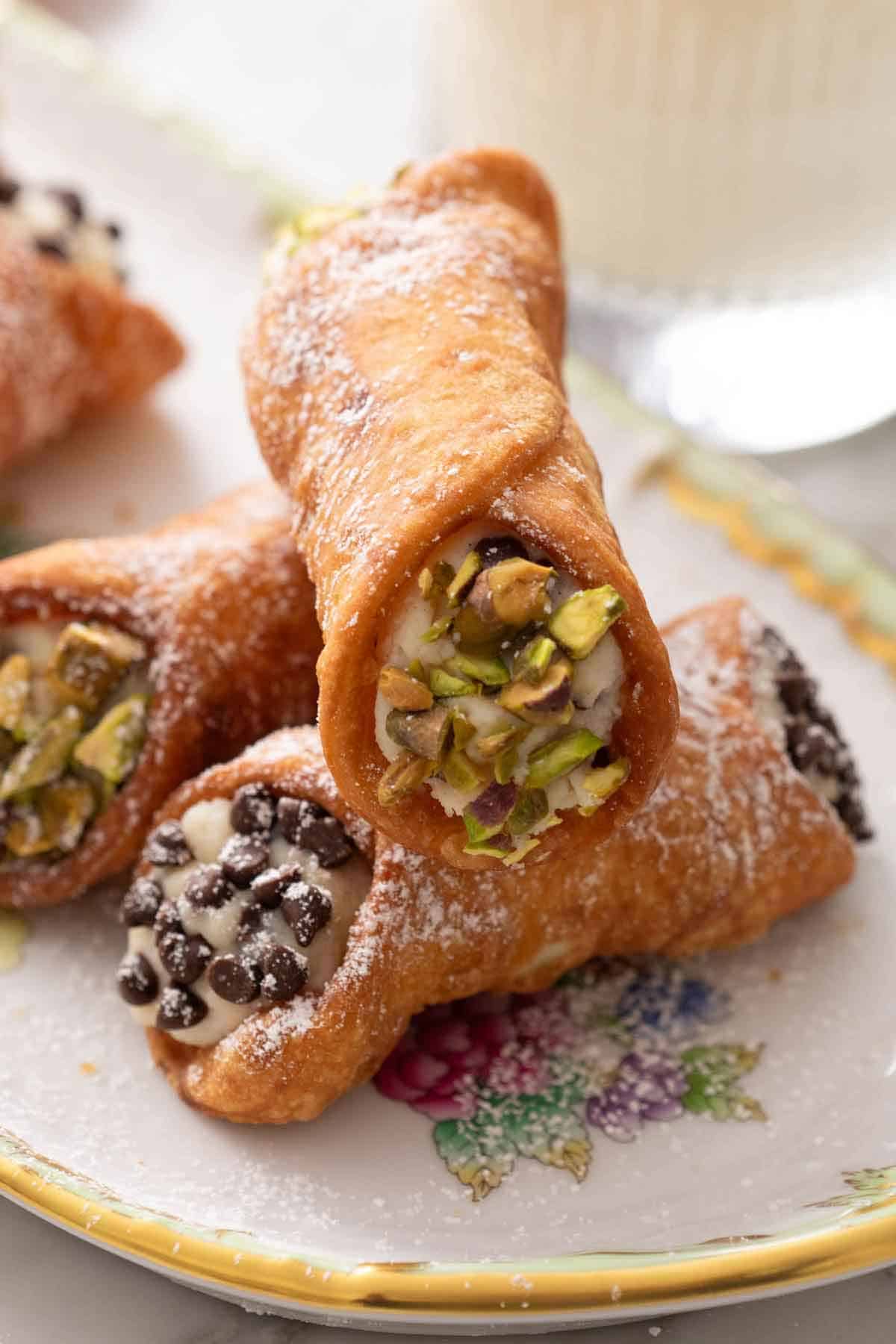
Frequently Asked Questions
Leftover cannoli can get soggy upon storage, so if you plan on having leftovers, fill only the cannoli you plan on eating and store the leftover shells and filling separately. Fried shells keep covered in an airtight container lined with paper towels at room temperature for up to 5 days. Store the remaining ricotta filling covered in the refrigerator for up to 5 days. Assemble the leftover cannoli immediately before serving.
Cannoli are always enthusiastically enjoyed, but they are a fantastic dessert to serve after almost any Italian meal, like pasta carbonara or air fryer chicken parmesan. Additionally, serve them for an afternoon treat with a shot of fresh espresso or a glass of chilled prosecco for a true Italian experience!
Yes, you certainly can make the dough without a processor. To do so, add the dry ingredients to a large mixing bowl and whisk together until combined. Using a pastry cutter or fork, cut the cold butter into the flour mixture until fine and crumbly. Drizzle in the marsala and egg, and mix well with a wooden spoon, adding additional wine as needed. Knead, rest, and proceed with the rest of the recipe as written.
If you’ve tried this cannoli recipe, then don’t forget to rate the recipe and let me know how you got on in the comments below, I love hearing from you!

Cannoli
Video
Equipment
- Large Pot
- Rolling Pin
- Cannoli forms
- Tongs
Ingredients
For the Shells:
- 2 cups all-purpose flour (240g)
- 2 tablespoons granulated sugar
- ¼ teaspoon salt
- 2 tablespoons unsalted butter cut into small pieces
- ½ cup marsala wine (120mL)
- 2 large egg yolks reserve white for brushing
- 2 quarts vegetable oil for frying
For the Filling:
- 32 ounces whole milk ricotta strained, (see notes) (900g)
- 1 cup powdered sugar (120g)
- ⅓ cup mini chocolate chips (60g)
- 1 teaspoon vanilla
- ¼ teaspoon cinnamon
Instructions
For the Dough:
- Add the flour, sugar and salt to the bowl of a processor and pulse to combine. Add the cold butter cubes and pulse until broken up into small pieces, about 8 pulses. Add the egg yolks and marsala and pulse until the mixture starts to clump together, you can add more wine a tablespoon at a time if needed to bring the dough together.
- Turn the dough out onto a lightly floured counter and knead for 3-4 minutes or until it forms a smooth and elastic dough. Cover and allow to rest at room temperature for an hour. (You can make the filling while the dough is resting if assembling in the same day.)
- Roll the rested tough to about ⅛-inch thick then cut into 4-inch circles. You can do this by hand or even use a pasta roller to create thin sheets. (If using a pasta maker start on 1 then keep rolling it through as you decrease the thickness until you get to the thinnest setting.) You can re-roll scraps if desired, but let them rest for 10 to 15 minutes before rolling out again.
- Heat the oil in a larger pot over medium heat and place a deep-fry thermometer in the oil. The oil should be 360°F when you fry so keep an eye on the temperature and adjust heat as needed.
- As the oil heats up, wrap the circles around your metal cannoli forms and use your finger to wipe some pf the reserved egg white where the ends will overlap, then press the ends together. (If you don’t seal the cannoli well they will open up in the deep fryer.)
- Fry the shells in batches for about two minutes or until deep golden brown. Use a spider or tongs to transfer to a wire rack lined with paper towels and let the shells drain. Immediately and carefully remove the metal forms. I like to wear an oven mitt then grab the shell with a paper towel, hold it vertically so the tube is pointing down, and gently press the end of the form onto the wire rack to free it from the shell. Continue wrapping the forms with dough and frying. Let the shells cool completely on the wire rack before filling.
For the Filling:
- Add the drained ricotta, powdered sugar, chocolate chips, vanilla, and cinnamon to a large bowl then stir together. Cover and chill filling for up to 1 day if not using immediately.
- When ready to use, transfer to a piping bag, snip the tip off and fill the shells, then press more chocolate chips onto the ends and dust lightly with powdered sugar.
Notes
- Make the ricotta filling while the dough rests. This will give the ricotta mixture time to chill before assembling the cannoli.
- Draining the ricotta. Removing the extra moisture from the cheese gives the filling a smooth and light texture and helps keep the shells from getting soggy. To drain the ricotta, place it in a tightly woven cheesecloth and squeeze the moisture out (as pictured above) or spread the ricotta out on paper towels in a fine mesh strainer or on a dinner plate before patting the cheese down with additional paper towels.
- Rolling the dough thin. To have delicately crispy shells, you will need to roll the dough thin, or to an ⅛-inch thickness. You can do this using a pasta machine or with a rolling pin.
- Re-rolling the scraps of dough. If using the scraps of dough to roll additional cannolis, let them rest for 10-15 minutes before rolling out again to keep the dough from getting tough or chewy.
- Keep an eye on the frying temperature of the oil. It is important to keep the oil at 360 degrees Fahrenheit while frying so the dough doesn’t burn or get soggy. Keep the frying thermometer in the pan throughout the frying process and adjust the heat as needed to maintain the temperature.
- Variation options. Add delightful light citrus notes to the ricotta filling by stirring 1 teaspoon of fresh orange zest into it. Alternatively, dip the cannoli in chopped pistachios or chopped candied fruits for a crunchy or fruity finish.



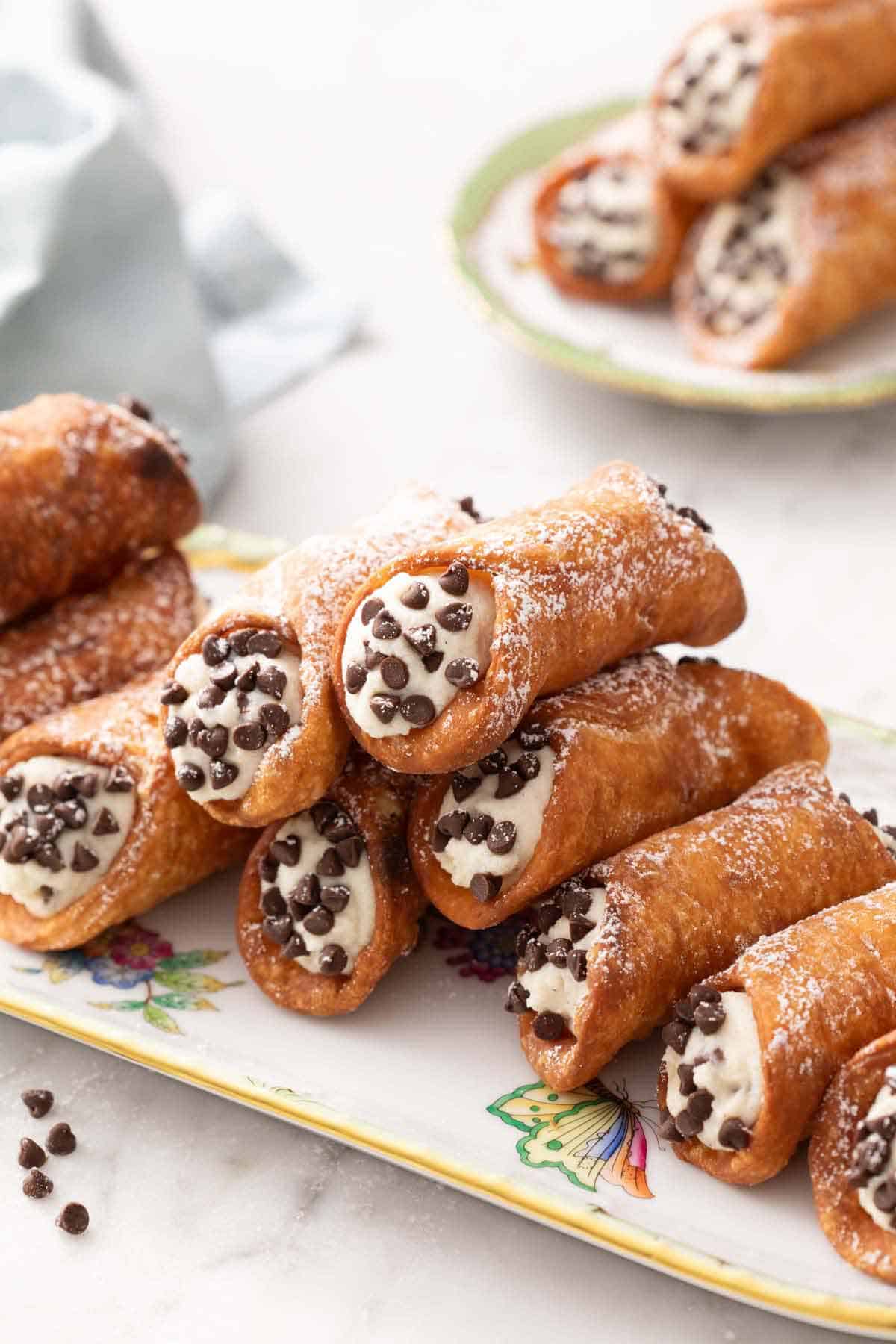




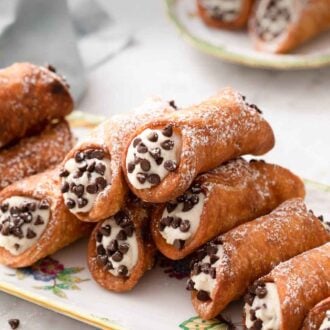
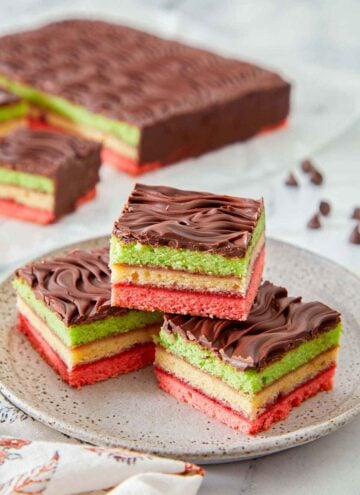

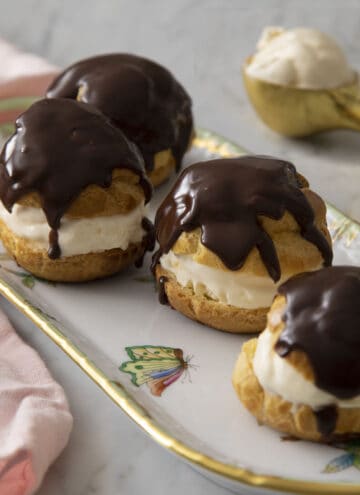
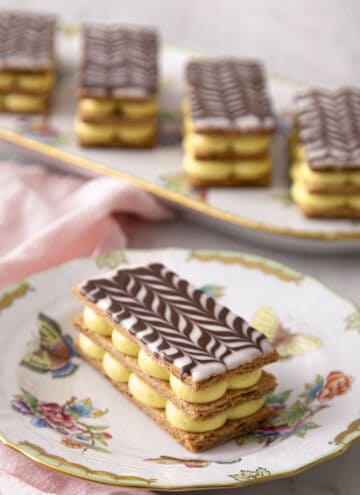
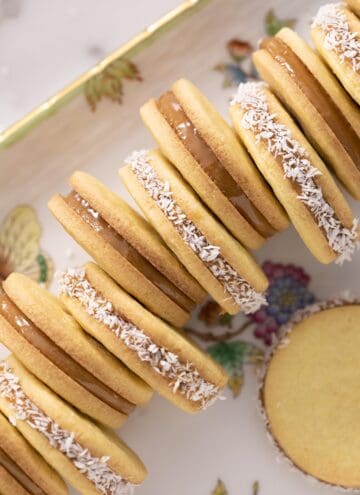

Heather says
These were delicious! The recipe was very simple and easy to follow. I did not have any wine so after looking up substitutes, I was able to sub it with 2 Tbsp. vinegar that was then topped with water to the 1/2 c. mark. I only ended up needing about 1/4 c. liquid. The filling/taste was different than what I was expecting because the last cannolis I had (which was years ago) might have been filled with mascarpone. But the ricotta was amazing and a great way to end pizza night! 🙂